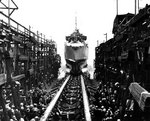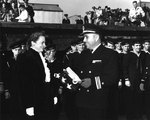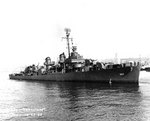Johnston
| Country | United States |
| Ship Class | Fletcher-class Destroyer |
| Builder | Seattle Tacoma Shipbuilding Corporation, Seattle, Washington, United States |
| Laid Down | 6 May 1942 |
| Launched | 25 Mar 1943 |
| Commissioned | 27 Oct 1943 |
| Sunk | 25 Oct 1944 |
| Displacement | 2,700 tons standard |
| Length | 376 feet |
| Beam | 40 feet |
| Draft | 18 feet |
| Speed | 35 knots |
| Crew | 273 |
| Armament | 5x5in, 10x40mm, 7x20mm, 2x5x21in torpedo tubes, 6x depth charge projectors, 2x depth charge tracks |
Contributor: C. Peter Chen
ww2dbaseJohnston was commissioned during WW2 with Lieutenant Commander Ernest E. Evans in command. "This is going to be a fighting ship", said Evans during the commissioning ceremony. "I intend to go in harm's way, and anyone who doesn't want to go along had better get off right now." She held her shakedown cruise off San Diego, California, United States.
ww2dbaseJohnston's first action took place three months later in the Marshall Islands where she bombarded the southern Kwajalein beaches on 1 Feb 1944, supporting the landing operations. During bombardment, gunnery officer Robert C. Hagen spotted a Japanese officer on the beach, waving a saber to instill morale as he coordinated the defenses. Hagen directed all five of Johnston's main 5-inch guns at the officer and fired, obliterating the Japanese officer. "Mr. Hagen, that was very good shooting", Evans said from the bridge. "But in the future, try not to waste so much ammunition on one individual." Between 17 and 22 Feb, she bombarded Eniwetok, again supporting landing operations. On 28 Mar, she bombarded Kapingamarangi Atoll in the Carolines. On 30 Mar, she bombarded Japanese positions near the mouth of the Maririca River, southeast of Empress Augusta Bay at Bougainville, Solomon Islands, and then performed a anti-submarine patrol off Bougainville. During this anti-submarine patrol, she sank the Japanese submarine I-176 by depth charges on 15 May 1944. Between 21 and 29 Jul 1944, she bombarded Guam of the Mariana Islands, sending in more than 4,000 rounds of shells and was credited with destruction of several Japanese 4-inch batteries and other military buildings. During the start of the Palau Islands action, she escorted carriers as the carrier planes supported ground operations at Peleliu.
ww2dbaseFollowing replenishment at Seeadler Harbor, Admiralty Islands, Johnston set sail on 12 Oct 1944 as an escort to the carriers of Escort Carrier Task Unit 77.4.3, nicknamed "Taffy 3", under the command of Rear Admiral Clifton A. F. "Ziggy" Sprague. The unit consisted of six escort carriers, three destroyers including Johnston, and four destroyer escorts. During the Battle of Sibuyan Sea on 24 Oct 1944, Admiral William Halsey's carrier aircraft attacked Vice Admiral Takeo Kurita's fleet, causing heavy damage which included the sinking of the battleship Musashi. Halsey was convinced that Kurita would not proceed with his original plans as he suffered such a heavy loss, so he sailed north with his carriers to chase Japanese carriers detected, which was dispatched for the very reason that they might lure Halsey away from the real objective. Kurita's fleet slipped through San Bernardino Strait without incident during the night of 24-25 Oct. At 0644, lookouts reported masts to the southeast, which were of Taffy 3. Although ships of Taffy 3 had nothing larger than 5-inch guns, they had no choice but to engage the Japanese ships because the escort carriers did not possess the speed to outrun the Japanese warships. The Japanese ships also pressed on aggressively from the beginning, largely because mis-identification made Kurita think that he had the opportunity to achieve a Mahanian victory against American cruisers and fleet carriers. Against the four battleships, seven cruisers, and at least 12 destroyers, Johnston's gunnery officer later reported "We felt like little David without a slingshot." The American ships laid a smoke screen to protect the escort carriers, zigzagging to make enemy aiming difficult. Not waiting for orders, Evans gave the order to go on the offensive. Johnston was lucky that the Japanese missed all attempts to hit her with gunfire, giving her an opportunity to return fire with 200 shells on cruiser Kumano with her small 5-inch guns. When she was closer, she fired 10 torpedoes, then immediately retreated from the engagement. At least one of the torpedoes hit Kumano, blowing off her bow. While in retreat, she was hit by 14-inch shells from battleship Kongo and then 6-inch shells from either a light cruiser or battleship Yamato. The first hit from Kongo left a three-by-six-foot hole in the main deck, penetrating all the way into the iron housing of the port propeller shaft's main reduction gears. The second hit from Kongo went through the deck and slashed critical electrical cables and steam lines before detonating against the main steam turbine of the after engine room. One of the 6-inch shells hit her on the bridge, wounding Evans with shrapnel, shearing off two fingers of his left hand, and then another 6-inch shell disabled her steering and after batteries. She hid in a squall as repair parties worked furiously. At 0750, Sprague ordered the destroyers and destroyer escorts to make a torpedo run. Although Johnston had already used all her torpedoes and one of the engines had been lost, Evans ordered her in anyway as a means to provide fire support and to draw fire from the ships that still had torpedoes. At 0820, she came within 7,000 yards from a Japanese battleship, and the guns fired 30 rounds within a minute, hitting the Japanese battleship several times. Then, she headed toward a heavy cruiser that had been attacking the escort carrier Gambier Bay, attempting to draw fire to save the escort carrier. After exchanging fire with the heavy cruiser, she took on an entire Japanese destroyer squadron that was on a torpedo run; Johnston's persistent attack forced the squadron to fire their torpedoes early, which was a major reason why all these torpedoes went astray. However, this final attack run against an entire destroyer squadron was also Johnston's last. After a shot hit her number one boiler room, steam was cut to the lone remaining engine, leaving her dead in the water. At around 0940, Japanese ships poured shells into Johnston as they sailed in semi-circles around the ship. A hit knocked out the forward gun, and then another hit on the 40mm ready ammunition locker left the already damaged bridge totally untenable. At 0945, Evans gave the order for the crew of Johnston to abandon ship. The destroyer was now a gruesome scene of death. Lieutenant Jesse Cochran, a survivor of Johnston, later recalled seeing "a pile of people - bodies - half alive, half dead" on the deck. At 1010, she rolled over and began to sink by the bow. "We all watched as our home for the past year slowly slid below the surface", recall survivor Bill Mercer. As the ship was sinking, a Japanese destroyer sailed extremely close. As the survivors braced for a raking by machine gun, they were surprised to see that Japanese sailors stood at attention and saluted at the sinking ship. Survivor Clint Carter saw that a "smartly dressed officer... on the wing of the bridge" saluting as well, possibly the captain of the Japanese destroyer.
ww2dbaseDuring the Battle off Samar, Johnston carried a complement of 327 men, out of which 186 were lost, which included the 92 that were alive in the water after the sinking but were lost to sharks, exposure, and dehydration. Evans, who was killed during the Battle off Samar, was posthumously awarded the Medal of Honor for the action off Samar.
ww2dbaseSources: the Last Stand of the Tin Can Sailors, United States Navy Dictionary of American Naval Fighting Ships.
Last Major Revision: Aug 2007
Destroyer Johnston Interactive Map
Photographs
 |  |  |  |
Johnston Operational Timeline
| 27 Oct 1943 | Johnston was commissioned into service. |
| 25 Oct 1944 | As Kurita’s Center Force closed on Clifton Sprague’s escort carriers off Samar, destroyer USS Johnston attacked and launched torpedoes against the cruiser Kumano, blowing off Kumano’s bow and forcing her withdrawal. |
Did you enjoy this article or find this article helpful? If so, please consider supporting us on Patreon. Even $1 per month will go a long way! Thank you. Share this article with your friends: Stay updated with WW2DB: |
Visitor Submitted Comments
8 Dec 2010 06:37:24 AM
The crew of the Johnston are heroes of a calibre rarely seen today. What they accomplished should be taught in every school to remind all of us what can be done through courage, loyalty and dedication to your fellow man.
God rest ye men.
14 Nov 2012 05:40:00 PM
yes that is my name Johnston! I hope that my family is related my dad was in W.W.2 Clifford R Johnston Jr.I'm very proud of him as well. He is gone now but sorely missed! he was on the uss president adams, Came home found my mom his childhood sweetheart and selltled down!!!!!!! THEY JUST DONT MAKE MEN LIKE THAT ANYMORE!! THANKS POP AND THE UNITED STATES OF AMERICA!I pray for our leadership today!!!!!! my dads breed will never be replaced!!
23 Jan 2013 04:14:34 PM
My dad had a cousin who survived the Johnston sinking. His name was Thomas Sullivan. I met him when I was young but at the time I didn't know his story. True heroes !
1 Mar 2013 06:08:41 AM
My father, David R. Wilkinson, was aboard a heavy crusier during the battle and watched the Johnston sink - knowing that his first cousin and very close friend, Jerry L. Clark was aboard. Jerry did not survive. Stories like this inspired me to serve my country and I spent 20 years in the USMC infantry and retired as a GySgt in 2003. My father has since passed but men like him, Jerry, and all the heroes who served and continue to serve our country will never be forgotten!
14 Nov 2013 08:55:37 AM
My father-in-law, Arnie Steiner, served aboard the USS Johnston. He would never speak of the experiance. It was only after his death did the family begin to find out what he had gone through.
These men aboard the USS Johnston, USS Hoel and USS Samuel B Roberts were truly heroes. They took the battle to the enemy and sent a vastly superior force high tailing it. This is the stuff that legends are made of.
11 Apr 2014 09:39:07 AM
Our Sailors and crew of the Johnston were the best we had to offer at that time. Lt. Cmndr Evans was one of the bravest, most forthright men to serve during the second world war. There is also much to be said of the Japanese sailors who were told during training that the Americans were an "inferior" race who would cower in the face fire. When the Japanese saw the Johnston fight, even when all was lost, they were awestruck at the fighting spirit of thier sailor counterparts. The salute was ordered by the captain of the ship according to Japanese survivors of the battle. They were ordered "sharpen their uniforms" and gather on the starboard side of the ship and salute smartly as they passed the sinking Johnston. This is one the great stories of World War two .
25 Oct 2016 02:08:22 PM
I was watching youtube the other night about ww2. My grandfather was a Marine that followed all these young men toward Japan. He has 3 purple hearts. I'm proud of him.
That being said. These Sailors on the Johnston are the most Badass men I have ever heard about. This ship and Crew made History.
These young men looked death in the face and never flinched. These men are what legends are made of.
10 Oct 2017 08:23:59 PM
Does anyone know if any of the sailors from the USS Johnston are still alive in 2017? Thanks
14 Dec 2017 12:47:00 PM
I just watched a program about the USS Johnson during WW2 and was overwhelmed at the strategy and courage of our American Sailors. I am so proud of our Military. Bless them all, they were and will always be the best of America.
7 Apr 2021 04:54:36 PM
Excellent article.....
Thank you.
All visitor submitted comments are opinions of those making the submissions and do not reflect views of WW2DB.
» Evans, Ernest
Event(s) Participated:
» Marshall Islands Campaign
» Mariana Islands Campaign and the Great Turkey Shoot
» Palau Islands and Ulithi Islands Campaigns
» Philippines Campaign, Phase 1, the Leyte Campaign
Related Books:
» The Last Stand of the Tin Can Sailors
- » 1,150 biographies
- » 337 events
- » 43,917 timeline entries
- » 1,241 ships
- » 350 aircraft models
- » 207 vehicle models
- » 374 weapon models
- » 123 historical documents
- » 260 facilities
- » 470 book reviews
- » 28,541 photos
- » 432 maps
James Forrestal, Secretary of the Navy, 23 Feb 1945
Please consider supporting us on Patreon. Even $1 a month will go a long way. Thank you!
Or, please support us by purchasing some WW2DB merchandise at TeeSpring, Thank you!
2 Aug 2010 12:03:47 PM
Commander Evans was a brave man. He employed the classic T formation. Too bad poor communication coupled with not guarding the San Bernardino Strait brought about such action. I guess Halsey was fooled or thought the Japanese carriers were full of planes (they in hindsight were not)and he was led to the North.